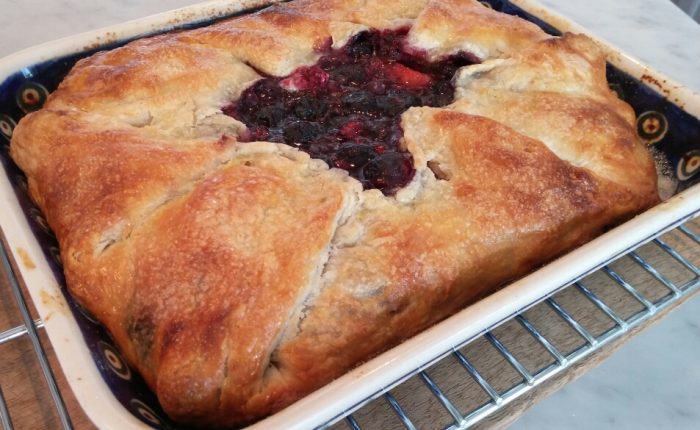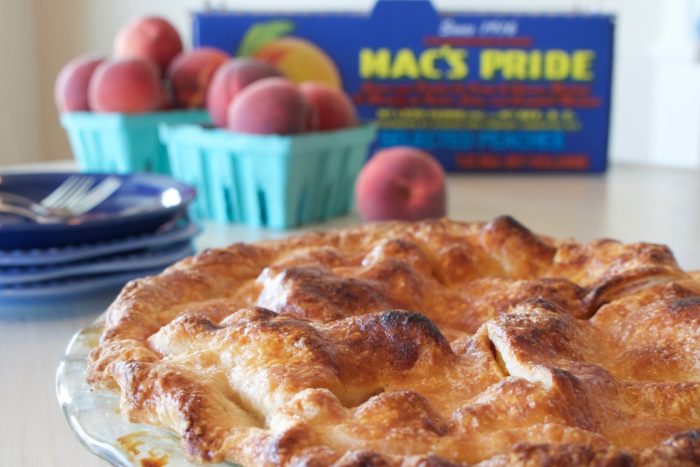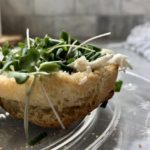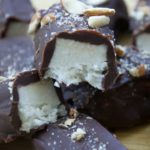This is a standard pie or tart crust recipe.
If you are intimidated by making your own crust, now’s the time to get over that. You don’t need any special magic or skill, just a little understanding of how things work. Here are the highlights.
- Overworking the dough, when rolling or adding the water is going to produce gluten, and you only want gluten when you are making bread so work this dough as little as possible.
- How the fat and flour combine determine how crumbly or flaky a crust is. If you overmix the fat (butter) into the flour the crust will be crumbly; think shortbread. If you barely mix the butter into the flour it will be flaky; think puff pastry.
- For pie and tart crust, it’s OK (even desirable) to have visible globs (dime size or less) of butter when you are rolling out the dough.
- The butter has to stay cold to stay in globs, so this is why you bring the dough together with ice water and why the dough rests in the refrigerator before rolling it out. It’s also why freezing pie or tart dough for later use is a good idea.
- There are multiple (too damn many, actually) resources online. Basically, just mix the stuff together as quickly as possible. Don’t overcomplicate this.
- The dough lasts about 3 months in the freezer. If you want some dough on hand, make several batches and freeze. Don’t double or triple the recipe because you will end up overworking the dough trying to mix all the butter in.
- I’m a fan of all butter everything. Crisco started out in the early 1900’s as an alternative substance for soap and candle making … but Procter Gamble, realizing Edison’s light bulb was coming, switched gears and marketed it as food. We know now that this original “vegetable oil” (it’s not from vegetables, it’s from seeds) was the first trans-fat. Crisco stands for “Crystallized Cottonseed Oil.”
- A combination of butter and Crisco does make a flaky crust. The master, Ina Garten’s recipe uses it, and the other master, Martha, does not. You do you.
- I figure people have been making entirely serviceable, if not delicious crusts well before Procter and Gamble figured out how to hydrogenate cottonseed oil. I am not just an all butter fan, I’m an organic unsalted butter fan.
Just look what you can do with this recipe.




Basic Pie and Tart Crust
Standard all-butter crust. Blitz a few dry ingredients, add some fat, let it rest in the refrigerator before using or freeze for later use.
Ingredients
Tart Crust
- 2 1/2 c unbleached all purpose flour 312 g
- 1 - 2 tsp sugar
- 1 tsp salt
- 2 sticks butter Cold, unsalted, cut into 1/4 inch cubes if you are making the crust by hand. Larger cuts are OK if you are using a food processor.
- 5 - 7 T ice water
- 1 9-inch tart pan with fluted edges and removable bottom for a tart, or a pie dish if you are making a pie
Instructions
- Before you start gathering ingredients, throw the bowl and blade of your food processor in the refrigerator to chill slightly. A totally optional step that may or may not contribute to the final product!
- In the bowl of a food processor fitted with a metal blade, dump the flour, sugar, and salt. Blitz a few times to mix.
- Add all the cold butter and pulse a few times, until the mixture forms little balls. Most recipes say you should get balls the size of peas. Personally, I like larger chunks of butter in a crust, so I try to stop before pea-size happens. Don't run the food processor and walk away; use short pulses and evaluate the consistency after each pulse. If you are making the crust with a pastry cutter, a fork, or your hands stop mixing when it's crumbly, and the dough is sticking into little balls. Smaller balls = a more crumbly crust and more massive balls = a more flaky crust.
- Remove the blade from the food processor and dump everything into a large bowl. Sprinkle with 3 - 4 T of ice water and use your hands to bring the dough together. You want it just sticking together. If the dough turns white and gooey, you've added too much water. If it keeps cracking and breaking apart, you need to add more ice water, but add it ONE T at a time.
- Turn the dough out onto a floured surface and bring it all together into a ball. Cut the dough in half, (use a scale for precision if you are that baker,) form each half into a disc, wraps the discs in plastic wrap and refrigerate for at least 30 minutes. Keeping the dough cold is what keeps the butter chunks as chunks, and chunks are what makes the crust flakey when cooked.
- Now you have a dough that can be used in 30 minutes - just roll it out, fill it and bake it. Or, it can be frozen for up to 3 months. (I think the best crusts come from dough that has been frozen and thawed gently in the refrigerator), or you can blind-bake or prebake the crust after the 30-minute chilled-rest if that's what your recipe calls for.
Using the Crust Immediately in a Tart or Pie
- After a 30 minute rest in the refrigerator, put some flour on the counter and roll out one disc into a circle about 3/8 inch thick and fit it into the pan. The rolling is fun, so it's easy to get the crust too thin. Stop yourself as soon as the disc is big enough to fit the pan.
- Measure your dough circle by holding the pan over the rolled out dough and eyeballing if you have a large enough circle to fit the bottom and go up the sides. About 2 inches wider than the pan-bottom-diameter is needed for a pie dish, less for a shorter-sided tart pan.
- Get the dough into the pan. There are many ways to do this. You can roll the dough over the rolling pin and unroll it over the pan. You can barely, gently fold the dough in half and maybe half again and then unfold it over the pan, or you might be able to just scoop, lift, and place over the dish. After trying the roll/un-roll and fold/unfold techniques I have settled on the scoop and lift method. Fewer steps = less to go wrong.
- Once the dough is in the dish, center the disc and press it down in the center and along sides. For a tart pan, press it into the flutes. There is so much butter in the crust, it won't stick once baked. Run the rolling pin over the top of the tart pan and cut away extra dough for a clean edge. For a pie, trim the overhang evenly and fold or crimp to make a decorative edge. If your pie has a top crust, roll out the second disc, fill the pie, place the crust on top, crimp, slice a few holes in the top so steam can escape.
- Mend any holes or rips with dough. Don't stretch the dough to fit because it will shrink back when it cooks.
Using the Crust Later (Par and Pre-baking)
- Position oven rack in the center and preheat to 350 when you put the dough in the refrigerator to rest.
- After the disc is chilled, roll it out to about 3/8 inch thick and place in the pie or tart pan as described above.
- LIne the bottom and sides of the dough with tinfoil. Fill the tinfoil with sugar (the sugar is your pie weight.) Bake 60 minutes. Check on it around the 35 - 40-minute mark and pull the tinfoil back from the edges if you want a golden-brown crust color. This method is from Serious Eats.
Notes
If you want to use a combination of shortening and butter, replace about 5 T of butter with shortening. But, before you do that, maybe check out these two references. Crisco started out as hydrogenated cottonseed oil in the early 1900's as an alternative to animal fat for soap and candle making. Edison's light bulb was on the horizon and in one of the most brilliant displays of re-branding/marketing, Procter and Gamble realized candle making was not the way to go. Enter the first trans-fat fake food: Crystallized Cottonseed Oil = Crisco.






1 Comment